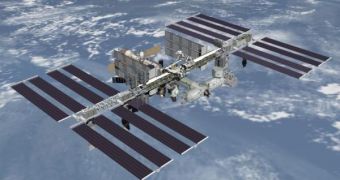The last spacewalk of the STS-119 Discovery mission to the International Space Station ended on a more somber note than NASA experts and crew members would have wanted, as the last objective of the three spacewalks, the deployment of a 5-square foot cargo platform, could not be completed. Despite the astronauts' best efforts, the inverted pin that prevented the complete deployment of the platform during Saturday's mission remained stuck in its place.
Joseph Acaba and Richard Arnold II, two former schoolteachers turned astronauts, struggled with the problem for a number of hours, but, despite their combined efforts, they failed to pry it open, so the platform remains half-deployed and half-stored. The Mission Control gave them orders to secure it as best as they could for the long-haul, so that it wouldn't cause any type of problems for the ISS in the future.
The spacewalkers used all their strength to unjam the pin, but failed with every attempt. They were even equipped with hammers, but even these proved to be useless. They didn't force the inverted pin to harden, however, as they wanted to avoid any further damage to the surrounding structures. Still, they manged to nudge it a bit, so maybe future extra-vehicular activity (EVA) missions will be able to completely remove it and deploy the platform.
These elements must all be deployed as soon as possible, as this is crucial for the good functioning of the space station. By 2010, all shuttle missions to the ISS will be canceled, as the American shuttle fleet will be withdrawn from active duty. Until 2015, the 16 nations involved in the $100-billion project will have no viable way of sending large cargo into orbit, so all reserve materials the crew on the lab might need have to be ferried this year and the next one.
The pieces that are too large to be stored inside will simply be attached to the outside cargo platforms, but, in order for that to happen, the latter have to be perfectly deployed. Flight director Kwatsi Alibaruho said that, “While it is kind of bittersweet in a way, we come from a culture that is used to achieving all the things we set out to achieve, we did accomplish all of the things that were critical.”

 14 DAY TRIAL //
14 DAY TRIAL //